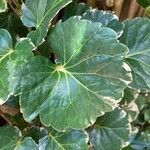Glabrous shrub or small tree, up to 6 m, with branches bearing spirally arranged leaves towards their ends. Leaves simple or trifoliolate, variable in size; petiole often c. 6 cm, but as long as 28 cm, with a sheathing base 1-6 cm long; lamina rotund or reniform, often c. 8 cm ø but as wide as 28 cm, margin usually serrate or becoming sub-lobed towards apex, in larger leaves the serrations often inconspicuous, apex rounded, base ± cuneate, midrib and lateral veins evident. Inflorescence a diffuse panicle; primary axis usually long (up to 1 m) with secondary branches (mostly in verticils, at intervals along its length; secondary branches 15-30 cm, bearing umbellules in an irregularly branched system towards their extremities; umbellules with c. 8-16 flowers, on pedicels c. 3 mm long. Calyx a minute rim. Petals 4-5, 2 mm long. Stamens 4-5, anthers oblong, 1 mm long. Ovary turbinate, c. 1 mm high, (2-)3-4-celled, styles at first erect, later recurved. Fruit subglobose, fleshy, c. 5 mm ø when dry.
A shrub which forms many branches from the base. It is 1-6 m high and spreads 1.5-3 m wide. The stems are bronze-green and there are distinct scars where the leaves fall off. The leaves have long leaf stalks and they can be simple or have 1-5 leaflets. The leaves are often cup shaped or saucer shaped. The leaf is elongated along the leaf stalk for about a quarter of its length. The leaves have teethed and are smooth on both sides. They are dark green on top and lighter green beneath. The leaf blade is 8-25 across and almost round or kidney shaped. The leaf stalk is 6-28 cm long. The flowers are 0.5 cm across. They are white or yellow. The fruit is 0.7 cm across and purplish-black. It is round and fleshy.

